Ultrathin Anode Buffer Layer for Enhancing Performance of Polymer Solar Cells
Abstract
A series of polymer solar cells (PSCs) based on poly[(4,8-bis-(2-ethylhexyloxy)-benzo[1,2-b:4,5-b′(dithiophene)-2,6-diyl-alt-(4-(2-ethylhexanoyl)-thieno[3,4-b]thiophene)-2,6-diyl] (PBDTTT-C) and [6,6]phenyl-C71-butyric acid methyl ester (PC71BM) were fabricated with various anode buffer layers. The power conversion efficiency (PCE) of PSCs was improved to 4.91% for the cells with PEDOT:PSS/LiF (1 nm) as anode buffer layer, which corresponds to 26.2% efficiency improvement compared with the cells with PEDOT:PSS as anode buffer layer. The PSCs with PEDOT:PSS/LiF as anode buffer layer show a maximum short-circuit density (Jsc) of 13.70 mA/cm2, with open circuit voltage (Voc) of 0.73 V and fill factor (FF) of 49.1% under illumination 100 mW/cm2 AM 1.5 G simulated solar light. The dominant mechanism for the performance improvement of PSCs could be attributed to the increased charge carrier collection ability by anode buffer layers.
1. Introduction
In the past ten years, as the demand for renewable energy becomes more and more urgent, polymer solar cells (PSCs) have been considered as next generation photovoltaic devices to solve energy crisis due to its many advantages, such as flexibility, light weight, environmental friendly, and easy large-area applications [1]. Many strategies have been introduced on improving the power conversion efficiency (PCE) and stability of PSCs, such as the development of novel donor and acceptor materials [2], the novel processing approaches to induce optimal microstructures in the active layer [3], and the optimization of interfacial buffer layer for efficient charge carriers collection [4]. The PCE of PSCs has been improved to more than 6% with a narrow band gap polymer poly[(4,8-bis-(2-ethylhexyloxy)-benzo[1,2-b:4,5-b′]dithiophene)-2,6-diyl-alt-(4-(2-ethylhexanoyl)-thieno[3,4-b]thiophene)-2,6-diyl] (PBDTTT-C). The key requirement for efficient operation of all-organic electronic devices is the process of the charge carriers injection and collection between active layer and electrodes. Therefore, the optimization of interfacial buffer layer is required to form ohmic contact for better charge carriers collection, resulting in increased short-circuit current density (Jsc) and fill factor (FF) of PSCs.
It is known that anode buffer layer plays an important role in determining the performance of organic light emitting diodes (OLEDs) and the PSCs. The operation mechanism of anode buffer layer is more complex in real PSCs. The main mechanism can be summarized as follows: (i) to adjust the effective work function of the electrode [5], (ii) to realize a vacuum level offset between the active layer and the electrode by forming a dipole layer [6], (iii) to increase built-in electric field by forming a tunneling junction [7], and (iv) to protect organic active layer from the hot electrode atoms during thermal deposition [8]. Helander et al. reported that the alkali halide (typically LiF in combination with an Al cathode) inserted between electrodes and the active layer can form a dipolar salt layer, then reducing the electron-injection barriers or extraction losses in the PSCs [9, 10]. As we know, poly(3,4-ethylenedioxythiophene):poly(styrenesulfonate) (PEDOT:PSS) is commonly used as anode buffer layer to enhance Jsc as well as open circuit voltage (Voc) for PSCs. PEDOT:PSS consists of PSS, which has hygroscopic and acidic characteristics. The PSS can corrode ITO and set off chemical reaction with the active layer materials, which degrades the cell performance [11]. In order to solve this problem, the metal oxides of zinc oxide (ZnO) [12], nickel oxide (NiO) [13], molybdenum oxide (MoO3) [14, 15], and tungsten oxide (WO3) [16] have been demonstrated as an effective replacement of PEDOT:PSS to improve the stability of PSCs. However, it is difficult to control the work function of the metal oxides for desired applications [17]. Recently, Chen et al. reported that solution-processed MoO3 doped into PEDOT:PSS extends the interfacial contact area between the active layer and PEDOT:PSS layer, which facilitates hole collection at the anode; the performance and stability of the PSCs were improved [18]. In this paper, we reported the effects of PEDOT:PSS/LiF as anode buffer layer on the performance of PSCs. The PCE of PSCs was improved to 4.91% with a PEDOT:PSS/LiF (1 nm) double anode buffer layer system, which leads to a significant efficiency improvement of about 26.2% compared with a single PEDOT:PSS buffer layer. The optimized PSCs have Jsc of 13.70 mA/cm2, with Voc of 0.73 V and FF of 49.1% under illumination 100 mW/cm2 AM 1.5 G simulated solar light.
2. Experimental Section
- Cells A:
Glass/ITO/PBDTTT-C:PC71BM/LiF/Al,
- Cells B:
Glass/ITO/LiF (1 nm)/PBDTTT-C:PC71BM/LiF/Al,
- Cells C:
Glass/ITO/PEDOT:PSS/PBDTTT-C:PC71BM/LiF/Al,
- Cells D:
Glass/ITO/PEDOT:PSS/LiF (1 nm)/PBDTTT-C:PC71BM/LiF/Al.
The absorption spectra of films were measured with a Shimadzu UV-3101 PC spectrophotometer. The current density-voltage (J-V) characteristics of the PSCs were measured using a Keithley 4200 source measurement unit and an ABET Sun 2000 solar simulator at room temperature in air. The external quantum efficiency (EQE) spectra were measured by a Zolix Solar Cell Scan 100. The schematic architecture of the PSCs, the molecular structures of PBDTTT-C and PC71BM, and the energy level structure are shown in Figure 1.
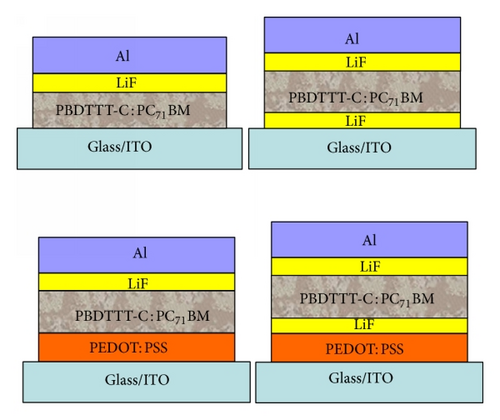

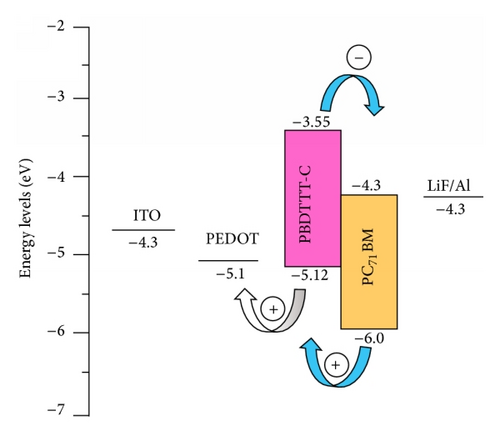
3. Results and Discussion
The normalized absorption spectra of pure PBDTTT-C and PC71BM films and their blend films (1 : 1.5) were measured and are shown in Figure 2. It is apparent thatpure PBDTTT-C films show a relatively strong absorption in the range from 600 nm to 750 nm and a relative weak absorption in the shorter wavelength range from 350 nm to 600 nm. The main absorption peak of PBDTTT-C locates at 700 nm. The highest occupied molecular orbital (HOMO) and the lowest unoccupied molecular orbital (LUMO) levels of PBDTTT-C are 5.12 eV and 3.35 eV, with the band gap of about 1.77 eV according to the absorption peak at about 700 nm [19]. There are two apparent absorption peaks at 375 nm and 480 nm for pure PC71BM films, which could broaden light absorption range of the blend films. Therefore, the normalized absorption spectrum of blend films shows two distinct absorption peaks at 460 nm and 700 nm, resulting from their absorption spectral overlap. Based on the PBDTTT-C:PC71BM as the active layers, a series of PSCs with various anode buffer layers were fabricated and measured under the same conditions.
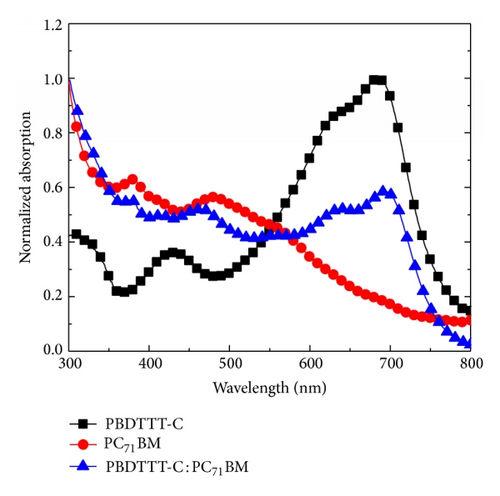
The current density-voltage (J-V) characteristic curves of PSCs were measured under dark conditions and are shown in Figure 3(a). It is apparent that Cells B, C, and D with anode buffer layers have lower leak current densities under reverse bias, compared with that of Cells A prepared on bare ITO substrates. This indicates that anode buffer layers could improve the interface between the ITO anode and the active layer. Cells D with PEDOT:PSS/LiF as anode buffer layer show the best diode quality with lower leak current density and high rectification ratio; the rectification ratio |J(1v)|/|J(−1v)| is as high as ~104.
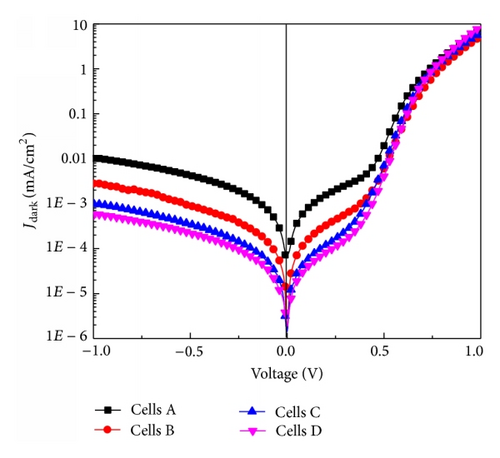
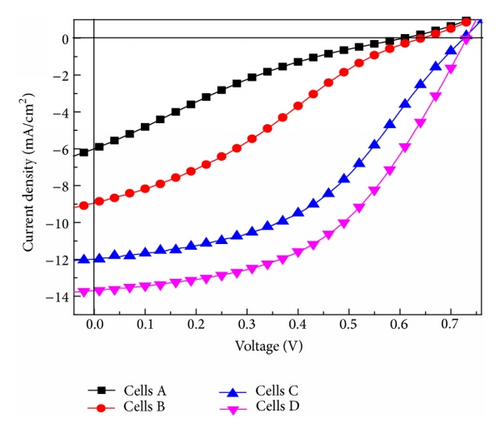
The J-V characteristic curves of PSCs with various anode buffer layers were measured under illumination 100 mW/cm2 AM 1.5 G simulated solar light and are shown in Figure 3(b). The key parameters of PSCs are summarized in Table 1. It is apparent that Cells D have relatively larger Voc than those of Cells A and B, and the Voc of Cells D remain almost the same compared with that of Cells C. As we know Voc of PSCs is primarily determined by two factors: (i) the energy levels difference between the HOMO of the electron donor and the LUMO of electron acceptor and (ii) the work function difference between anode and cathode electrode [20]. It could be assumed that the improved Voc of Cells D was due to the changes of anode work function since the active layer fabrication condition and the cathode layer deposition remain constant. The work function of PEDOT:PSS (5.1 eV) is 0.4 eV higher than that of ITO (4.7 eV). The PEDOT:PSS layer can effectively tune the work function of ITO substrates for Cells C and D. According to the Voc of Cells C and D, the thin LiF layer may have no obvious effect on the work function of ITO substrates. It is worthwhile to mention that the Jsc of Cells D is 13.70 mA/cm2, which is a 14.4% increase compared with that of Cells C. The increase of Jsc could be attributed to the enhancement of holes extraction efficiency by the ultrathin anode buffer layer. It is known that PEDOT:PSS is conductive polymer with high ductility, which could be considered as a kind of metal. The metal-insulator-semiconductor (MIS) model could be formed, which is based on PEDOT:PSS/LiF/organic active layer, because LiF and organic active layer materials are commonly considered as insulator and semiconductor, respectively. As reported by Xi et al. when the generated holes in the active layer come to the interface of LiF/organic active layer, a large number of them will pass through the ultrathin LiF layer by the tunneling [21]. The FF of Cells D is increased about 10.3% compared with that of Cells C. This may be due to the improved interfacial contact between the active layer and PEDOT:PSS layer due to the insertion of a thin LiF layer. Kim and Chang reported that a thin LiF layer evaporated onto PEDOT:PSS layer could reduce film roughness, which shows smooth surface morphology of the anode buffer layer [22]. It is known that the shunt resistance (Rsh) and series resistance (Rs) are two important parameters in the PSCs. In contrast to Cells C, the Rsh of Cells D was increased about 19% and the Rs was decreased about 44% due to the insertion of a thin LiF layer. The Rsh is generally associated with leakage current which is determined by the film quality and its interfaces. Small Rsh results from the loss of charge carriers through leakage paths including pinholes in the films and the recombination and trapping of the carriers during their transit through the active layer [23]. The Rs is mainly related to the contact resistance between the active layer and anode electrode. The decrease of Rs of Cells D should be attributed to the formation of a better ohmic contact due to the insertion of a thin LiF layer.
| Samples | Voc | Jsc | FF | Best PCE | *Ave. PCE | Rs | Rsh |
|---|---|---|---|---|---|---|---|
| (V) | (mA/cm2) | (%) | (%) | (%) | (Ω cm2) | (Ω cm2) | |
| Cells A | 0.61 | 6.0 | 19.3 | 0.71 | 0.63 ± 0.08 | 177.1 | 95.7 |
| Cells B | 0.64 | 8.96 | 29.5 | 1.69 | 1.66 ± 0.03 | 115.5 | 284.0 |
| Cells C | 0.73 | 11.98 | 44.5 | 3.89 | 3.82 ± 0.07 | 36.2 | 321.6 |
| Cells D | 0.73 | 13.70 | 49.1 | 4.91 | 4.86 ± 0.05 | 20.1 | 381.9 |
- *Average PCE: more than 30 cells were evaluated.
In order to further clarify the effect of the LiF interlayer on performance of the PSCs, the external quantum efficiency (EQE) spectra of Cells C and D are investigated and shown in Figure 4. It is observed that there is an increase in the EQE at wavelengths between 360 nm and 720 nm for Cells D in comparison to Cells C. The EQE of Cells D with a thin LiF layer is increased up to 60%, which exhibits efficient photon-to-electron conversion. The EQE spectra of PSCs also demonstrate that PEDOT:PSS/LiF as anode buffer layer could play positive effect on charge carrier collection. The adopting appropriate interfacial layers may provide an effective method to improve the performance of PSCs.
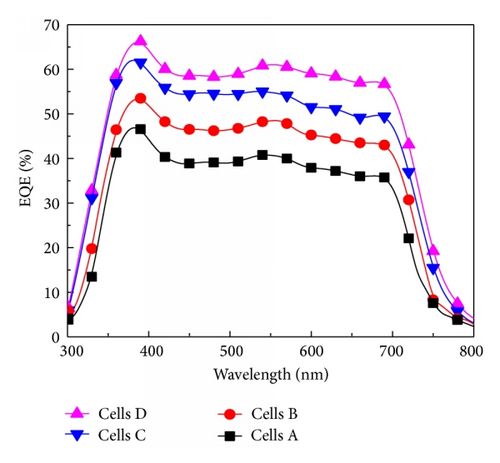
4. Conclusions
In summary, a series of PSCs based on PBDTTT-C and PC71BM as active layer were fabricated to investigate the anode buffer layers on the performance of PSCs. The performance of PSCs with PEDOT:PSS/LiF as anode buffer layer was improved compared with the cells fabricated on bare ITO substrates, LiF/ITO substrates, and PEDOT:PSS/ITO substrates. Cells D maintain a maximum Jsc and FF, yielding a highest PCE of 4.91%, which has a 26.2% improvement compared to the cells with PEDOT:PSS buffer layer. The improvement performance of PSCs can primarily be attributed to the efficient holes collection induced by the interfacial layer. The PEDOT:PSS/LiF anode buffer layer has positive effect on PSCs based on P3HT:PCBM system. These findings indicate that the optimization of anode buffer layer is an effective method for the improvement of PSCs.
Conflict of Interests
The authors declare that there is no conflict of interests regarding the publication of this paper.
Acknowledgments
This work was supported by Fundamental Research Funds for the Central Universities (2013JBZ004); National Natural Science Foundation of China (61377029); Beijing Natural Science Foundation (2122050); and the State Key Laboratory of Catalysis, CAS (n-11-09).




